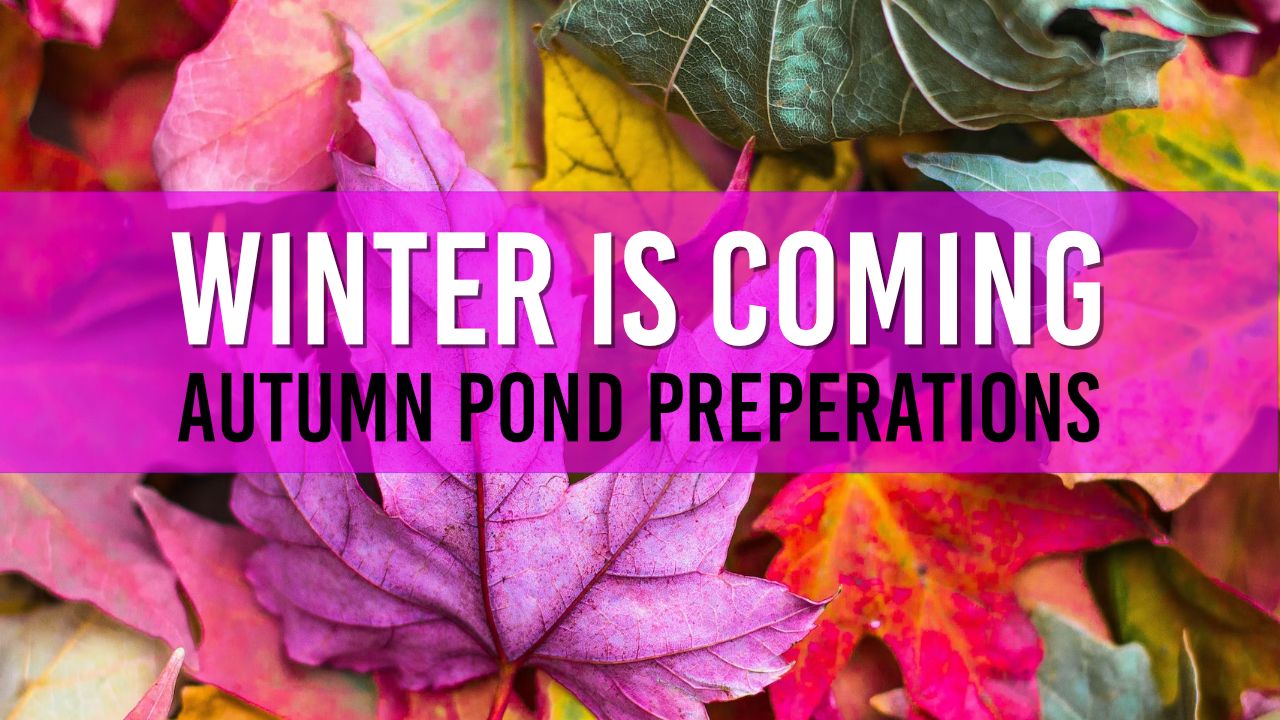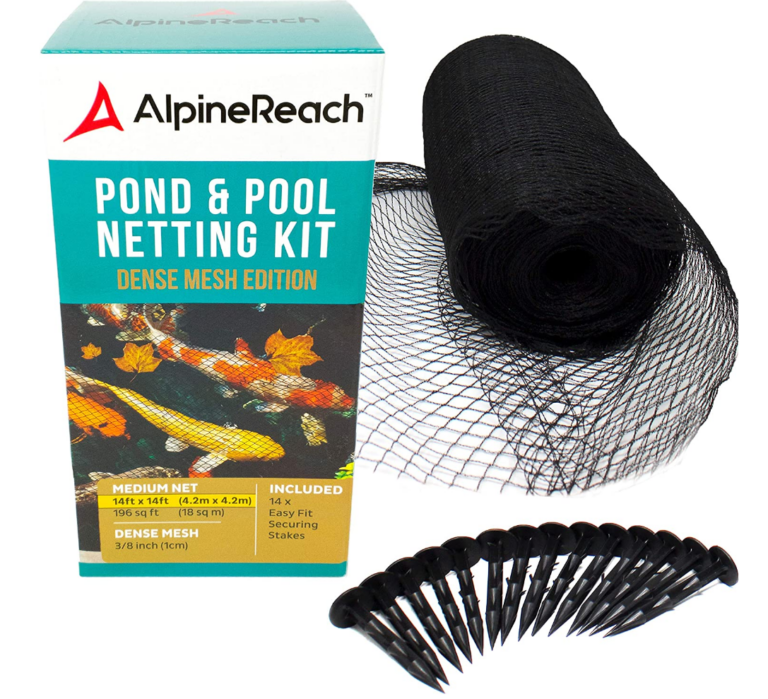Prepare your pond for Autumn – My Ultimate guide!
Prepare your Pond for Autumn with my free helpful guide. Clear your pond of all floating debris, clean out the pump cage and filter boxes and cover to protect your pond over winter.

Table of Contents
With Autumn just around the corner, it’s that time of year where we must prepare our pond for the cooler weather, falling leaves and higher winds. Pond owners new and old need to be aware of changes they must make to ensure their fish not only survive the cooler months, but their filtration system is performing at its peak performance to ensure the health of their fish.
In this article I will be covering the steps I take every September to ensure my pond is not overwhelmed with additional falling leaves / nuts. The article will go over the basic preparations pond owners should follow, and any tips & hints that I’ve learnt over the years.
I also reveal my number 1 product to aid you with your pond pond preparations.
Should I reduce the amount of food I feed my fish in Autumn?
During the summer months we feed our fish at least twice per day. Our pond has Koi, Orfe, Goldfish, Sturgeon (and many other breeds). We feed them a selection of sinking pellets along with floating pond sticks from Amazon.
However, as the temperature starts to decrease, our fish feeding schedule changes to just a single time per day. Fish will use the summer months to add fat to their bodies which is then stored and used over the cooler months.
Low quality, low fat foods will cause problems with your fish’s winter survival.
During the months of September is the period of time just before my fish will not even come to the surface to feed, so we like to ensure they have enough fat reserves to last them throughout winter.
Special notice much be taken with how much you feed your pond fish during the cooler months. Once you chuck food into your pond, give the fish around 10-15 minutes to eat it all up. If food is still in your pond after this time, it’s best to remove it – then the following day reduce the amount of fish food.
If the fish food is all gone in a few minutes, then add a bit more and do so until the food has been consumed within 10-15 minutes.
Autumn Pond Preparations for your Filtration system
As the summer monthly slowly slip away, the weather changes with trees / plants shedding their once beautiful green leaves into brown/red enemies of the pond. Higher wind speeds will result in more leaves, nuts and even branches falling into your pond.
Pond Pump Cleaning
Pond pumps are the heart of your filtration system. They suck water from your main pond and pump it to your filter boxes. As mentioned above – as more debris falls into your pond, you need to make sure it has the best opportunity to suck it up and send to your filter box.
To clean your pond pump, the process is quite simple:
- Turn off all electrics to your pond (pump, UV light)
- Remove the pond pump from your pond
- Remove any pump cage (either clips or 4 metal screws)
- Hose down the entire pump including cage
- Remove any small twigs / branches from the impeller
- Reconnect all pipes and place back onto the bricks in your pond
Cleaning your Pond Pipework
Pond pipes often get overlooked during maintenance, however as the veins/archeries of your filtration system I would suggest always cleaning them out before the cooler weather finally hits. Pond pipes take water from your pump to the filter box, so any blockages such as sludge, twigs etc will severely impact overall cleaning performance.
How to clean your pond pipes:
- Turn off all pond electrics
- Remove your pond pump from the water and disconnect the hose
- Trace the pipe back to your filter box and disconnect
- Using your hose pipe, spray water through the pipe and keep shaking to remove any sludge
- Reconnect your pipe
Pond Filter cleaning preparations
Pond Filters are like the kidneys of your filtration system, ensuring they are clean and able to filter water through their sponges will greatly benefit your pond. Your filters will be subjected to a greater amount of debris than usual, so ensuring they are clean will truly help keep your pond clear, and water healthy through until winter.
I have already written a guide on how to clean your filter sponges here, however the basic steps are as follows:
- Turn off your pond electrics
- Disconnect the pipes to and from your filter box
- Remove the lid of your filter box
- Remove and clean each filter sponge using a hose
- Clear out any sludge
- Replace all filter media and reconnect all pipes
Increased debris entering your pond during Autumn

As the temperature drops during the Autumn months, you will notice that leaves start to fall from trees. This can start to cause problems for your pond water and filtration system. Leaves will float on the surface of your pond then eventually sink to the bottom. As the leaves then break down, they can release harmful chemicals and introduce harmful external bacteria to your water.
Our pond sits beneath conifer trees along with some very tall pine and horse chestnut trees – which means our pond gets completely covered in pine needles & conkers.
The first year we built our pond, we were quite late in covering our pond, and ended up scooping out hundreds (probably thousands) or pine needles / pine cones and conkers. Unfortunately many pieces of debris had already sunk to the bottom of our pond causing our pond pump to look like a hedgehog!
Not only did the leaves / pine needles / conkers fill our pond, but it also required daily maintenance to ensure the water did not become harmful for our selection of fish – a very time consuming process!
How I stop leaves falling into my pond during Autumn
I always prefer preventing an event rather than dealing with an event – hence the preparations I make for Autumn. The first year I built my raised pond in a new location I underestimated the amount of debris (leaves, pine needles, pine cones, conkers, twigs etc) that fell into the water.
Since then, I took action and built some fixed covers using plastic mesh and some 2″ x 2″ wooden frames to cover 95% of the pond, which has resulted in less Spring maintenance!
Every time I feed my fish, I lift and tilt the pond covers to remove any fallen leaves, remove any pine needles that have fallen through the mesh and replace back. Just doing this small 2 minute task every day has saved me hours in pump and filter cleaning!
If you’re not really into making your own wooden frames, then anything you can place over your pond which will still allow light & oxygen through will work fine. I know of some pond owners that put sheet plastic over their pond in the colder months – but I've never really been a fan. I much prefer to allow at least “some” sunlight into the water.

Pond Netting Kit
For lighter tree debris (the odd leaf here and there) standard pond netting will suffice which for “in ground” ponds can be secured using tent pegs.
For wooden sleeper raised ponds, you could add small hooks for the netting to attach to, or just order netting much larger than the size of your pond and secure with rocks/bricks.
The downside of pond netting is its flexibility. If your pond has a lot of leaves falling in, your netting will start to bow into the water where harmful bacteria and bird poop can enter which in turn could affect the health of your fish.
Should I turn my UV Lamp off over winter?
Every pond owner has their own opinions regarding UV filter lamps. Personally for me, I leave my UV lamp on 365 days a year unless I am cleaning my pond/filters. The UV lamps purpose is to break down algae (which causes green water) and causes it to clump together which is then filtered out by your sponges.
Colder temperatures during Autumn means there is not as much algae growth and therefore understand why some pond owners will save electricity costs and switch off their lamp.
Keeping my UV lamp “always on” gives me re-assurance that if we have a warmer winter, my pond will not be overrun with algae which will require me to clean my sponges / pump (yes I'm lazy) – as mentioned before, I prefer to prevent problems than deal with them. I’ve found no adverse effects to my pond by keeping my UV light powered during winter – in fact, my bulbs seem to last longer than those who turn them off.
I would suggest that when you’re performing your maintenance you clean the UV bulb for maximum efficiency – preparing for the warmer weather the following year.
Products I should purchase for my pond preparations
To anybody that knows me, they know I don’t like to spend money unless it benefits my pond. If your pond has run absolutely fine over the summer months, then I don’t think you need to invest in new pumps or filter boxes, however there is 1 product that will make your life 1000% easier.

Sturdy Metal Pond Net
The pond net is your best friend when scooping out debris and other fallen media that has entered your pond.
Purchasing a high quality pond net will ensure it can cope with the heavy rubbish without the handle bending or snapping.
The only other product which would really benefit your pond pump is a cage. These can be quite tricky to find that will fit your existing pump, however fitting one will reduce blockages and most importantly protect your pump impeller from becoming stuck due to twigs/leaves.
Pond Preparations Summary
I hope you enjoyed my guide, as with all things in life – if you are able to prepare for upcoming events, you are already ahead of the game. Ponds are no different, just like when you expect hotter weather you add more oxygen to the pond, preparing for Autumn will save you countless hours in the future ensuring your pond looks great for the following year!
My Final Autumn Pond Preparations Checklist
- Reduce the amount of food you feed your fish
- Ensure you’re using high quality fish food to increase fat reserves
- Clean your filtration system
- Pond Pump
- Pond Pump Cage
- Pipe work
- Filter Box
- UV Lamp
- Cover your pond to prevent leaves from falling into the water
- Clean out any leaves / twigs / debris from your pond water

